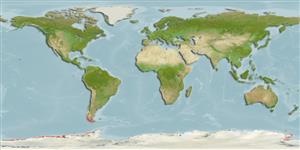Common names from other countries
Classification / Names / Names
Κοινά ονόματα | Συνώνυμα | Catalog of Fishes (gen., sp.) | ITIS | CoL | WoRMS
Environment: milieu / climate zone / depth range / distribution range
Οικολογία
; εύρος βάθους 10 - 30 m (Ref. 87801). Subtropical
Antarctic Pacific and Southeast Pacific: Antarctica and Chile. Subtropical to polar.
Length at first maturity / Μέγεθος / Βάρος / Age
Maturity: Lm ? range ? - ? cm
This species is usually found epizoic on other hydroids, e.g. Symplectoscyphus sp. at depths of 10 to 30 m (Ref. 87801).
Life cycle and mating behavior
Γεννητική Ωρίμανση | Αναπαραγωγή | Γεννοβολία | Αβγά | Γονιμότητα | Προνύμφες
Members of the order Anthoathecata are mostly colonial A-form hydroids. Life cycle: The zygote develops into planula inside the gonophore and is later released as an actinula which metamorphoses into polyp stage.
Häussermann, V. and G. Försterra. 2009. (Ref. 87801)
IUCN Red List Status (Ref. 130435)
CITES status (Ref. 108899)
Not Evaluated
Not Evaluated
Threat to humans
Harmless
Human uses
| FishSource |
Εργαλεία
Περισσότερες πληροφορίες
Κοινά ονόματαΣυνώνυμαΘηρευτέςΑναπαραγωγήΓεννητική ΩρίμανσηΓεννοβολίαΓονιμότηταΑβγάEgg development
Age/Size
Αύξηση
Length-weight
Length-length
Μορφολογία
Προνύμφες
Αφθονία
Διαδικτυακές πηγές
Estimates based on models
Preferred temperature
(Ref.
115969): -1.8 - -1.2, mean -1.8 (based on 28 cells).
